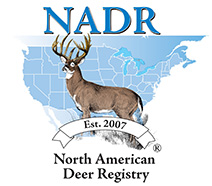








ABOUT US



FREQUENTLY ASKED QUESTIONS
1) What is DNA?
DNA is a molecule that is present in every cell of an animal. It is unique and specific for each individual (except for identical twins). Offspring inherit half of their DNA material from their biological sire and half from their biological dam.
2) What is a DNA Genetic Profile?
This is an identification method whereby we can use the information from a DNA Genetic Profile in order to determine pedigrees.
3) Why do I need DNA testing on my animals?
DNA testing can be used for several purposes, all of which can protect and add value to your deer-breeding program. Providing proof as to the sire and dam of a fawn, determining if your AI was successful or identifying a poorly performing buck or doe are a few examples.
4) What kind of a sample do I need?
The most common samples that we work with is hair. Other acceptable samples are whole blood, tissue pieces, antler shavings and semen.
5) What kind of sample works best?
The best samples are the ones that have been collected, stored and shipped correctly. Blood must be shipped in proper blood vials, hair must be pulled so to include the roots, antler shavings must be obtained from the hardest region within the antler core, and tissue must be cut and placed immediately into an alcohol collection tube for shipping to the lab.
6) How do I send the samples?
Blood samples should be sent using overnight couriers, and the sample should be packed with a cold pack. All others listed may be sent through regular mail.
7) Where do I send the samples?
Samples should be sent to NADR 1601 Medical Center Drive, Suite 1, Edmond
OK 73034.
8) How long does it take?
DNA testing is normally completed in approximately 10 to 15 business days depending on volume and workload in the laboratory.
9) What type of documentation will I receive?
You will receive a Parentage Verification Certificate listing the animal identification information and the identification of confirmed Sire and/or Dam that had been requested with each animal tested.
10) Can I make comparisons to other deer?
The genetic profile for your deer sample can be compared with any NADR profile in the database. You will not need to seek the individual owner’s permission for comparisons as long as the animal is in NADR.
11) Can I identify Grandparents of my deer?
Unfortunately there is no way to skip a generation due to inbred populations. We must compare to the immediate sire and dam and any lineage confirmed will follow on to the fawn. Grandparents represent second-degree relatives and, as such, are similar to aunts, uncles and a host of other related animals that share parentage back a generation.
12) I have shed antlers. Can I get a genetic profile from this?
Shed antlers can be used for genetic analysis; however, these should be used only as an alternative if the animal is dead. If the animal is available, it is always best to obtain a sample directly from it (tissue, blood or hair). If a set of shed antlers were to be misidentified, all subsequent comparisons to them would be in error.
13) I have a dead deer. What can I do?
Success of the genetic profile depends on the condition of the remains, how it is sampled, stored and shipped to the laboratory. If remains are discovered within a day, some parts can provide good samples for a genetic profile. We have been successful with material from a remaining leg bone. A small portion of the leg was cut off, placed in an alcohol sample collection tube and sent to our laboratory.
Rotting and decaying animal remains do not work well for genetic analysis. If an animal dies of unknown causes and is found soon after it dies, a tissue sample could be obtained by cutting off a part of the ear and immediately putting it into an alcohol sample collection tube. Samples from dead animals that have been frozen can be sampled in the same way. Old skeletal bones can be used; however the age and condition of the remains greatly affect the ability to recover DNA for the genetic profile.
14) What happens if my certified deer dies?
A Death Notification Form should be filled out and sent to NADR. NADR will then update the registry.
15) What are the numbers that I have been assigned?
TDA or NADeFA or VDM Member #:
This number identifies the ANIMAL OWNER’s member, farm/ranch, corporation or other entity, and is unique member ID.
NADR #
This number is issued for every animal you have tested in the NADR. It is used to internally track the specimen you send to be tested. It can be found directly under the Animal Name on the Parent Verification Certificate for each animal. Please reference the NADR # for animal identification.
1) What is DNA?
DNA is a molecule that is present in every cell of an animal. It is unique and specific for each individual (except for identical twins). Offspring inherit half of their DNA material from their biological sire and half from their biological dam.
2) What is a DNA Genetic Profile?
This is an identification method whereby we can use the information from a DNA Genetic Profile in order to determine pedigrees.
3) Why do I need DNA testing on my animals?
DNA testing can be used for several purposes, all of which can protect and add value to your deer-breeding program. Providing proof as to the sire and dam of a fawn, determining if your AI was successful or identifying a poorly performing buck or doe are a few examples.
4) What kind of a sample do I need?
The most common samples that we work with is hair. Other acceptable samples are whole blood, tissue pieces, antler shavings and semen.
5) What kind of sample works best?
The best samples are the ones that have been collected, stored and shipped correctly. Blood must be shipped in proper blood vials, hair must be pulled so to include the roots, antler shavings must be obtained from the hardest region within the antler core, and tissue must be cut and placed immediately into an alcohol collection tube for shipping to the lab.
6) How do I send the samples?
Blood samples should be sent using overnight couriers, and the sample should be packed with a cold pack. All others listed may be sent through regular mail.
7) Where do I send the samples?
Samples should be sent to NADR 1601 Medical Center Drive, Suite 1, Edmond
OK 73034.
8) How long does it take?
DNA testing is normally completed in approximately 10 to 15 business days depending on volume and workload in the laboratory.
9) What type of documentation will I receive?
You will receive a Parentage Verification Certificate listing the animal identification information and the identification of confirmed Sire and/or Dam that had been requested with each animal tested.
10) Can I make comparisons to other deer?
The genetic profile for your deer sample can be compared with any NADR profile in the database. You will not need to seek the individual owner’s permission for comparisons as long as the animal is in NADR.
11) Can I identify Grandparents of my deer?
Unfortunately there is no way to skip a generation due to inbred populations. We must compare to the immediate sire and dam and any lineage confirmed will follow on to the fawn. Grandparents represent second-degree relatives and, as such, are similar to aunts, uncles and a host of other related animals that share parentage back a generation.
12) I have shed antlers. Can I get a genetic profile from this?
Shed antlers can be used for genetic analysis; however, these should be used only as an alternative if the animal is dead. If the animal is available, it is always best to obtain a sample directly from it (tissue, blood or hair). If a set of shed antlers were to be misidentified, all subsequent comparisons to them would be in error.
13) I have a dead deer. What can I do?
Success of the genetic profile depends on the condition of the remains, how it is sampled, stored and shipped to the laboratory. If remains are discovered within a day, some parts can provide good samples for a genetic profile. We have been successful with material from a remaining leg bone. A small portion of the leg was cut off, placed in an alcohol sample collection tube and sent to our laboratory.
Rotting and decaying animal remains do not work well for genetic analysis. If an animal dies of unknown causes and is found soon after it dies, a tissue sample could be obtained by cutting off a part of the ear and immediately putting it into an alcohol sample collection tube. Samples from dead animals that have been frozen can be sampled in the same way. Old skeletal bones can be used; however the age and condition of the remains greatly affect the ability to recover DNA for the genetic profile.
14) What happens if my certified deer dies?
A Death Notification Form should be filled out and sent to NADR. NADR will then update the registry.
15) What are the numbers that I have been assigned?
TDA or NADeFA or VDM Member #:
This number identifies the ANIMAL OWNER’s member, farm/ranch, corporation or other entity, and is unique member ID.
NADR #
This number is issued for every animal you have tested in the NADR. It is used to internally track the specimen you send to be tested. It can be found directly under the Animal Name on the Parent Verification Certificate for each animal. Please reference the NADR # for animal identification.

OUR STORY
MANAGEMENT STAFF
BOARD OF DIRECTORS AND OFFICERS
FREQUENTLY ASKED QUESTIONS
MANAGEMENT STAFF
BOARD OF DIRECTORS AND OFFICERS
FREQUENTLY ASKED QUESTIONS
© North American Deer Registry
1601 Medical Center Drive, Suite 1
Edmond, OK 73034
Office: (405) 513-7228
Fax: (405) 513-7238
Email: nadr@deerregistry.com
1601 Medical Center Drive, Suite 1
Edmond, OK 73034
Office: (405) 513-7228
Fax: (405) 513-7238
Email: nadr@deerregistry.com